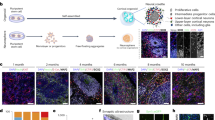Abstract
1. The growth inhibitory factor (GIF) is a 68-amino acid protein which is capable of inhibiting the growth of neuronal cells in vitro.
2. We have cloned and sequenced the 5′-flanking region of the mouse GIF gene, which spans from the transcriptional initiation site to the −1854 nucleotide.
3.This region contains sequences homologous to hgcs, SPE, and the JCV silencer domain that functions in a glial cell specific manner. This region also contains two metal responding elements and putative binding sites for AP-1, AP-2, Sp-1, SP-2, NF-1, and CREB.
4. An analysis of the reporter plasmids containing the various regions of the 5′-flanking sequence revealed that the region indeed functioned in a tissue-specific manner in glial cells and that the region between −328 and 175 is responsible for suppression, while the region between −175 and −49 is involved in the activation of gene expression.
Similar content being viewed by others
REFERENCES
Appel, S. H. (1981). A unifying hypothesis for the cause of amyotrophic lateral sclerosis, parkinsonism, and Alzheimer's disease. Ann. Neurol. 10:499–505.
Aravamudan, B., Watabe, M., and Watabe, K. (1993). Characterization of the 5′-flanking region of the hepatocyte growth factor gene. Biochem. Biophys. Res. Commun. 195:346–353.
Benda, P., Lightbody, J., Sato, G., Levine, L., and Sweet, W. (1969). Differentiated rat glial cell strain in tissue culture. Science 161:370–371.
Besnard, F., Brenner, M., Nakatani, Y., Chao, R., Purohit, H. J., and Freese, E. (1991). Multiple interacting sites regulate astrocyte-specific transcription of the human gene for glial fibrillary acidic protein. J. Biol. Chem. 266:18877–18883.
Brewer, G. J., and Ashford, J. W. (1992). Human serum stimulates Alzheimer markers in cultured hippocampal neurons. J. Neurosci. Res. 33:355–369.
Faisst, S., and Meyer, S. (1992). Compilation of vertebrate-encoded transcription factors. Nucleic Acids Res. 20:3–26.
Gorman, C. M., Moffat, L. F., and Howard, B. H. (1982). Recombinant genomes which express chloramphenicol. Mol. Cell. Biol. 2:1044–1051.
Henikoff, S. (1987). Unidirectional digestion with exonuclease II in DNA sequence analysis. Methods Enzymol. 155:156–165.
Ihara, Y. (1988). Massive somatodendritic sprouting of cortical neurons in AD. Brain Res. 459:138–144.
Jiang, H., Shah, S., and Hilt, D. (1993). Organization, sequence, and expression of the murine S100 b gene. J. Biol. Chem. 268:20502–20511.
Kumar, G., Srivastava, D. K., and Tefera, W. (1994). A 70-to 80-kDa glial cell protein interacts with the AGGGAAGGGA domain of the JC virus early promoter only in the presence of the neighboring cis DNA elements. Virology 15:116–124.
Luckow, B., and Schutz, G. (1987). CAT constructions with multiple unique restriction sites for the functional analysis of eukaryotic promoters and regulatory elements. Nucleic Acid Res. 15:5490.
Palmiter, R., Findley, S. D., Whitmore, T. E., and Durnam, D. (1992). MT-III, a brain-specific member of the metallothionein gene family. Proc. Natl. Acad. Sci. USA 89:6333–6337.
Sambrook, J., Fritsch, E. F., and Maniatis, T. (1989). Molecular Cloning, Cold Spring Harbor Laboratory, Cold Spring Harbor, NY.
Sanger, F., and Coulson, A. R. (1975). A rapid method for determining sequences in DNA by primed synthesis with DNA polymerase. J. Mol. Biol. 94:441–448.
Searle, P. F., Davison, B., Stuart, G. W., Wilkie, Tm., Norstedt, G., and Palmiter, R. D. (1984). Regulation, linkage, and sequence of mouse metallothionein I and II genes. Mol. Cell Biol. 4:1221–1230.
Seguin, C., Felber, B. K., Carter, A. D., and Hamer, D. H. (1984). Competition for cellular factors that activate metallothionein gene transcription. Nature 312:781–785.
Topp, W. C. (1981). Normal rat cell lines deficient in nuclear thymidine kinase. Virology 113:408–411.
Trapp, G. A., Miner, G. D., Zimmerman, R. L., Mastri, A. R., and Heston, L. L. (1978). Aluminum levels in brain in Alzheimer's disease. Biol. Psychiatry 13:709–718.
Uchida, Y., and Tomonaga, M. (1989). Neurotrophic action of Alzheimer's disease brain extract is due to the loss of inhibitory factors for survival and neurite formation of cerebral cortical neurons. Brain Res. 481:190–193.
Uchida, Y., Takio, K., Titani, K., Ihara, Y., and Tomonaga, M. (1991). The growth inhibitory factor that is deficient in the Alzheimer's disease brain is a 68 amino acid metallothionein-like protein. Neuron 7:337–347.
Author information
Authors and Affiliations
Rights and permissions
About this article
Cite this article
Watabe, M., Gross, S., Lawyer, C. et al. Sequence and Functional Analysis of the 5′-Flanking Region of the Mouse Growth Inhibitory Factor Gene. Cell Mol Neurobiol 17, 235–243 (1997). https://doi.org/10.1023/A:1026369913405
Issue Date:
DOI: https://doi.org/10.1023/A:1026369913405




